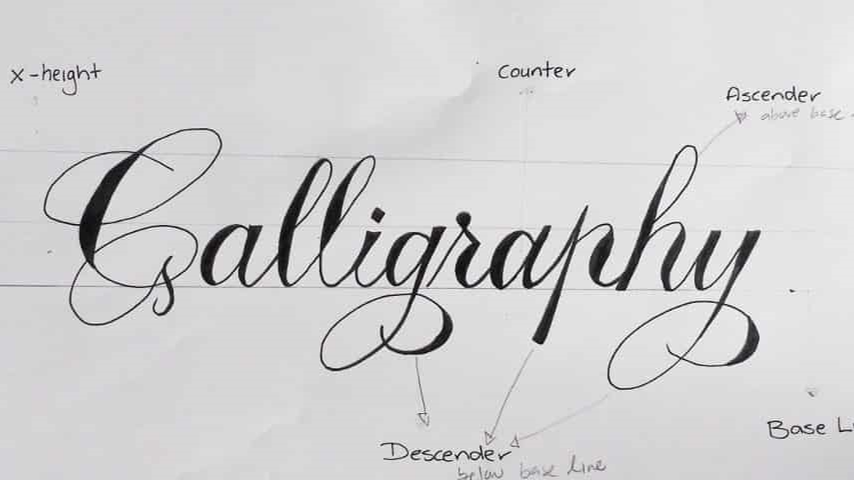
CALLIGRAPHY
What is Calligraphy? Can it be pursued as a profession?
Before the printing press and computers revolutionized document creation, manuscripts were the primary medium for recording information, encompassing religious texts and historical records. Calligraphy, the exquisite art of lettering using various pens and feathers, flourished in ancient civilizations like the Greeks, Romans, Arabs, and Chinese. The term "calligraphy" originates from the Greek words "calligraphia" and "calligraphein," where "calli" denotes "beautiful" and "graphia" signifies "writing," encapsulating the essence of this art as "beautiful writing." Early calligraphers employed wooden pens and large feathers dipped in a plethora of inks, each stroke a testament to their skill. As time progressed, the tools of calligraphers evolved. Modern practitioners utilize pens with nibs of varying sizes and shapes, their instruments larger and more robust than conventional writing implements.
Despite technological progress, the creation of new fonts remains a human endeavor. Computers alone cannot generate fonts; they require the expertise of a calligrapher, a master of handwriting. Thus, calligraphy retains its significance as an esteemed art form, blending tradition with innovation in visual communication.
What are the responsibilities of a calligrapher?
In today's digital age where printing and computer typesetting are prevalent, calligraphers still have plenty of work. Their main task is designing new fonts and styles for computer use. Have you noticed how each newspaper has its own unique lettering style? That's the result of months of effort by calligraphers. Calligraphers are also sought after for tasks like creating elegant lettering for wedding invitations and embellishing degree and diploma certificates. Some companies even hire calligraphers to design their logos and brand names. For instance, the logo of Emirates, a leading airline, is crafted using calligraphy.
As a result, advertising agencies are keen on hiring individuals skilled in calligraphy. Those proficient in this art can earn substantial monthly salaries.
What would you like to hold?
In studying calligraphy, your marks from SSLC and plus two don't matter. If you can write neatly, you can boldly pursue this field, even if you've only completed class 10. Becoming a good calligrapher requires more than just neat handwriting. You also need steady hands to hold a brush, patience to work for long hours, intelligence to translate ideas into letters and words, and a passion for art. While knowing how to paint isn't necessary, many famous calligraphers are also artists. If your handwriting isn't great but you can paint, don't worry—practice under a calligrapher to improve.
New calligraphers need to work not only on paper but also on computer screens. They should also get training in some software programs.
Where to Study?
Academic qualifications don't determine a calligrapher's skill, which is why calligraphy isn't typically a standalone subject in universities or colleges.Instead, students pursuing B.A. Fine Arts are introduced to basic calligraphy principles like scripts, fonts, and strokes.
However, numerous private institutes across the country offer calligraphy courses, accessible through online and distance learning formats. Notable training centers include Indira Gandhi National Centre for the Arts (IGNCA) and Calligraphy India in New Delhi, Achyut Pallav School of Calligraphy and Vikrant Karia Institute of Art in Mumbai, Artistic Calligraphy in Nagpur, Right Right in Indore, and Sri Yogeshwari Institute of Handwriting in Bangalore.
In Kerala, calligraphy institutes operate in nearly every district, catering to individuals of all ages. However, these institutes often prioritize handwriting improvement courses over advanced calligraphy training, resulting in limited job opportunities for graduates.To address this, the government or fine arts colleges could introduce formal calligraphy courses, ensuring comprehensive training and better job prospects for aspiring calligraphers. Ultimately, passion and dedication matter more than the institution where one learns calligraphy. With consistent practice, even self-taught individuals can excel in this art form.
Job opportunities in this field:
Those who have experienced life in the Gulf countries understand the profound respect and admiration the Arab community holds for calligraphy. Perhaps it's the inherent grace of Arabic script or the sheer beauty of words woven into intricate designs, but there's a distinct allure to calligraphy in the Arab world. Owning a Quran adorned with calligraphy is cherished by many, symbolizing both spiritual devotion and artistic appreciation. Additionally, it's a common delight among locals to see their names artistically crafted in Arabic script, often taking the form of birds or animals, adding a personalized touch to their identity.
Beyond the Gulf, Kerala has also witnessed a surge in calligraphy enthusiasts. A contemporary trend involves commissioning calligraphers to design wedding invitations, elevating them to treasured keepsakes for VIP weddings. Moreover, calligraphy isn't confined to paper alone; it extends to diverse mediums such as posters, movie titles, and even business cards. Companies keen on leaving a lasting impression often opt to have their brand names delicately rendered in calligraphy on ceramic plates and glasses, serving as elegant complements to their offerings. For lots of people, calligraphy isn't just about art—it's also a way to make extra money. They smoothly fit it into their work lives and earn some cash on the side.
Article By: Mujeebulla K.M
CIGI Career Team
